Where is the fan on a MacBook Air?
Where is the fan on a MacBook Air?
Ever wondered where the fan is situated in your MacBook Air? Understanding the fan’s location is crucial for proper ventilation and maintaining optimal performance. In this guide, we’ll pinpoint the precise spot where the fan resides in your MacBook Air, ensuring you’re equipped with essential knowledge about your device’s cooling system.
Uncover the hidden secret: where does the fan hide on a MacBook Air?
The MacBook Air, known for its slim and lightweight design, features a passive cooling system that sets it apart from some other MacBook models. Unlike traditional laptops with dedicated cooling fans, the MacBook Air uses a passive heatsink design, and as a result, it doesn’t have an active cooling fan.
The cooling system in the MacBook Air primarily relies on the following components:
- Passive Heatsinks: These are thermal components that dissipate heat from the internal components, such as the processor (CPU) and other chips. The heatsinks are designed to distribute heat and allow it to escape into the surrounding air.
- Thermal Architecture: The MacBook Air is engineered to generate less heat compared to MacBook Pro models, thanks to its energy-efficient processors. The internal components are strategically positioned to optimize heat distribution.
- Convection and Ventilation: The MacBook Air uses convection, which is the natural flow of heat, to help keep the device cool. It relies on the case’s design to allow hot air to rise and escape from the system. While the MacBook Air doesn’t have traditional vents or fans, it is designed to maintain effective airflow through the casing.
It’s important to note that the absence of a cooling fan is a deliberate design choice to keep the MacBook Air slim and quiet. This cooling system works well for typical use cases, but it’s not suitable for resource-intensive tasks that generate a significant amount of heat. MacBook Air models are best for everyday computing, such as web browsing, document editing, and multimedia consumption, rather than tasks that require heavy processing power and extensive cooling. For tasks that demand high performance and generate more heat, MacBook Pro models with active cooling systems are more suitable.
What Are the Limitations of the Passive Cooling System in the MacBook Air?
While the passive cooling system in the MacBook Air offers several advantages, it does have some limitations, particularly when compared to laptops with active cooling fans. One notable limitation is its suitability for tasks that demand high processing power for extended periods. Tasks like video editing, 3D rendering, or running resource-intensive software can cause the internal components to generate significant heat. Without an active fan to quickly dissipate this heat, the MacBook Air may experience thermal throttling, where the processor’s speed is automatically reduced to prevent overheating. This can result in a performance dip during prolonged, demanding tasks.
Additionally, the absence of a fan may lead to a slight increase in the overall operating temperature of the MacBook Air during extended usage. While this isn’t necessarily harmful, users may notice the bottom of the laptop becoming warmer than laptops with active cooling systems. This is a trade-off for the MacBook Air’s slim and lightweight design, as the absence of a fan allows for a more compact and portable form factor. It’s worth noting that for users who frequently engage in resource-intensive tasks, a MacBook Pro with an active cooling system may be a more suitable choice to ensure consistent high performance without the risk of thermal limitations.
How Does the MacBook Air Handle Tasks that Generate Higher Heat Levels?
The MacBook Air is designed to handle a wide range of tasks efficiently, but when it comes to activities that generate higher heat levels, it may face some challenges due to its passive cooling system. For tasks that are particularly demanding, such as graphic-intensive gaming, video rendering, or running resource-heavy applications, the MacBook Air’s thermal management strategy may come into play. Users are advised to operate their MacBook Air on a flat, hard surface to facilitate heat dissipation. Placing it on a soft surface like a bed or a cushion can hinder the cooling process, potentially causing the device to warm up more quickly. Additionally, users should be aware that extended periods of running resource-intensive applications may lead to higher operating temperatures, and in some cases, the MacBook Air may resort to thermal throttling to prevent overheating. This means that the processor’s speed may be temporarily reduced to manage heat levels, which can result in a slight dip in performance.
Unlike some Intel-based Macs, which might resort to a loud fan noise when faced with high thermal loads, the MacBook Air’s passive cooling system operates silently, providing a noise-free computing experience. However, it’s important for users engaged in heavy tasks to be mindful of the potential for increased heat buildup. In such scenarios, monitoring the device’s temperature and taking breaks to allow it to cool down can help ensure optimal performance. For tasks that consistently generate high heat levels, users might want to consider a MacBook Pro, which is equipped with an active cooling system that includes a fan to manage thermal loads more effectively.





You must be logged in to post a comment.